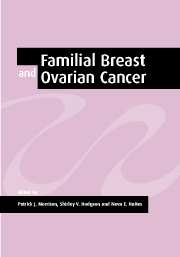Book contents
- Frontmatter
- Contents
- List of contributors
- Foreword by Helena Kennedy
- Preface
- Acknowledgements
- Part 1 Molecular biology and natural history
- 1 Introduction
- 2 Overview of the clinical genetics of breast cancer
- 3 Cowden syndrome and related disorders
- 4 Overview of the clinical genetics of ovarian cancer
- 5 Ovarian and breast cancer as part of hereditary non-polyposis colorectal cancer (HNPCC) and other hereditary colorectal cancer syndromes
- 6 The natural history of hereditary breast cancer
- 7 Pathology of the breast and ovary in mutation carriers
- 8 Risk estimation for familial breast and ovarian cancer
- Part 2 Screening
- Part 3 Management
- Index
3 - Cowden syndrome and related disorders
Published online by Cambridge University Press: 24 August 2009
- Frontmatter
- Contents
- List of contributors
- Foreword by Helena Kennedy
- Preface
- Acknowledgements
- Part 1 Molecular biology and natural history
- 1 Introduction
- 2 Overview of the clinical genetics of breast cancer
- 3 Cowden syndrome and related disorders
- 4 Overview of the clinical genetics of ovarian cancer
- 5 Ovarian and breast cancer as part of hereditary non-polyposis colorectal cancer (HNPCC) and other hereditary colorectal cancer syndromes
- 6 The natural history of hereditary breast cancer
- 7 Pathology of the breast and ovary in mutation carriers
- 8 Risk estimation for familial breast and ovarian cancer
- Part 2 Screening
- Part 3 Management
- Index
Summary
Introduction
The differential diagnosis of familial breast and ovarian cancer must always include Cowden syndrome (CS, Mendelian Inheritance in Man Catalogue Number (MIM) 158350). CS, also known as multiple hamartoma syndrome, is named after Rachel Cowden (Lloyd and Denis, 1963), who died of bilateral breast cancer in her early thirties (Brownstein et al., 1978). It is an under-diagnosed, under-recognized, autosomal dominant inherited cancer syndrome characterized by hamartomas, which can develop from derivatives of any of the three germ-cell layers, and carries a high risk of breast, thyroid and possibly endometrial cancers (Eng, 2000b). Germline mutations of PTEN, a tumour suppressor gene localized to 10q23.3, are associated with the great majority of CS cases (Nelen et al., 1996; Li et al., 1997; Liaw et al., 1997; Marsh et al., 1998b). Other syndromes, such as Bannayan–Riley–Ruvalcaba syndrome (BRR, MIM 153480) and a previously unclassified Proteus-like syndrome, which previously were not suspected of having an increased risk of cancer, have also been found to be partly accounted for by PTEN mutations (Marsh et al., 1997a, 1999; Zhou et al., 2000b).
Clinical aspects
Epidemiology
Because the diagnosis of CS is difficult, the true incidence is unknown. Prior to gene identification, a population-based estimate in Amsterdam was one in a million (Starink et al., 1986; Nelen et al., 1996). However, after identification of the susceptibility gene, the same population base yielded an incidence of one in 200 000 (Nelen et al., 1997, 1999), although the latter is still likely to be an under-estimate.
- Type
- Chapter
- Information
- Familial Breast and Ovarian CancerGenetics, Screening and Management, pp. 22 - 42Publisher: Cambridge University PressPrint publication year: 2002



